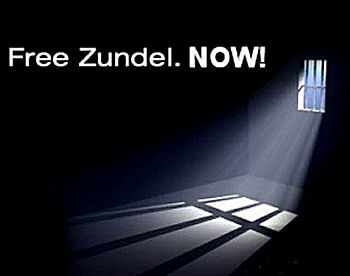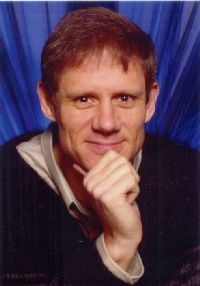| Breaking news from freedom's front line
The Trial of Germar Rudolf in Mannheim District Court
DAY 2, 16 Nov 2006
Reported by Günter Deckert | Translated by J. M. Damon
MANNHEIM, GERMANY -- The trial of chemist Germar Rudolf for the “crime” of the German legal equivalent of “Holocaust denial.” Scheduled to begin at 9 o’clock, the trial began at 9:05 a.m.
The following members of the court were present:
1. The same judges as on opening day, Schwab presiding;
2. District Attorney Grossmann with female assistant;
3. Defense Attorneys Stolz and Bock;
4. One bailiff, five armed uniformed policemen and 2 plainclothes political police (staschus);
5. Representatives of press and media – none (scared off, presumably);
6. Others: Around fifty spectators whose composition changed from time to time, including Dr. Rolf Kosiek of Grabert Publishing House. Nine schoolchildren were present at opening of morning session, six still present at lunch break, none after lunch.
Judge Schwab opened proceedings and allowed Germar Rudolf to continue speaking.
Rudolf informed the Court that he was considering several motions that he wished to discuss with his attorneys, whereupon the Court recessed at 9:07 a.m. and resumed at 9:27 a.m.
Attorney Stolz then objected that Germar had once again been placed in leg irons. Judge Schwab remarked that during the previous session he had ordered the leg irons removed while the prisoner was inside the courthouse. He said he would see to it that in future, Germar would not be transported from Heidelberg Prison in irons.
Germar then had his attorneys distribute to the Court and to Grossmann, photocopies of documents relevant to his Tuesday presentations and augmenting it in detail. Among these photocopies were supporting statements by the Director of Prisons in the state of Missouri in the USA. Included was an introduction by Prof. Faurisson explaining that the engineer Fred A. Leuchter is the leading expert on homicidal gas chambers in the United States. (This statement was taken from an expert report presented during the trial of Ernst Zündel in Toronto.)
Other documents that Germar presented included plans and photographs of several buildings and parts of buildings of the Auschwitz concentration camp. Here Germar referred to his critically annotated edition of the various Leuchter expert reports. This publication is available in English under the title Fred A. Leuchter, Robert Faurisson. Germar Rudolf. The Leuchter Reports: Critical Edition. Chicago, USA, 2005. It is dedicated to Ernst Zündel (“For Ernst”) and available at www.vho.org
Germar then continued with a chronological account of his life history and accomplishments in establishing a foothold in the USA. This account, which was also presented during proceedings of the first trial day (14 November), is found in his publication Kardinalfragen an Deutschlands Politiker – Aufforderung zur Wiederherstellung der Menschenrechte in Deutschland (Cardinal Questions About Contemporary History) available online at www.vho.org
Then came revelations that were completely new (and not just to me!) concerning Germar’s collaborations with Peter Stahl, a nephew of “Gestapo Müller”. Stahl is a citizen of the US and the son of a relative of Müller who immigrated to the US. Germar wrote these revelations in collaboration with Bob Crowley, a former high ranking member of the FBI who wrote an independent account of the Kennedy assassination.
Crowley's account inspired Germar to edit and publish a book entitled Regicide that thus far has appeared only in English. Germar ascribed his deportation from the USA as being in large part a consequence of publishing this book.
Germar then related that the initial phase of his residence in the US was interrupted by a short stay in Mexico near the residence of Bradley Smith.
Smith is the founder of CODOH (Committee for Open Debate on the Holocaust) a pioneering organization in support of unfettered historical research and scientific investigation of what Prof. Norman Finkelstein calls the “Holocaust Industry.” Despite advanced age, Smith continues to be very active in the field of historical revisionism. Germar also carried on extensive correspondence with Fridjof Mayer, an editor of Spiegel magazine, who recently published a controversial article on the probable number of Auschwitz deaths in the magazine Südosteuropa.
At 10:50 the presiding judge called another recess, which lasted until 11:25. Germar then described the books he published in 2005, in particular a series on the subject of Auschwitz. The author of these books is the Italian revisionist researcher Carlo Mattagno, whom GR described as the most knowledgeable researcher of the concentration camps in eastern Europe.
At 12:42 Judge Schwab adjourned the Court for the midday meal, with re-adjournment at 2:00 pm.
At the afternoon session only a single bailiff and two uniformed policemen were present, in addition to the two staschu agents. After describing his scientific and publishing activities, Germar addressed six fundamental issues concerning basic human rights in a free and democratic society.
a) The Scientific Attitude: Germar explained the vital importance of the scientific attitude in human affairs, referring to several prominent authorities cited by the prosecution, who stressed the importance of the “human compulsion to know the truth.” He described himself as an “eternally curious researcher with a compulsion to know, and incapable of submitting to the compulsion to believe, or accept on faith.” (At this point, Female Judge Number Two dedicated her full attention to massaging her eyes)
b) Forensic Investigations: Germar remarked that the forensic aspects of “Holocaust,” that is, technical examination of the “homicidal gas chamber as murder weapon,” has been completely ignored by established authority for over 40 years.
c) Human Dignity and the Instinct to Learn the Truth: Everyone, including Germar, has the human right to question official veracity. That is simply the right to criticism. In accordance with this inalienable right, Germar is resisting oppression by the State as well as well as official intervention in free and unhindered investigation and research: Kant’s Sapere Aude (Dare to know.)
d) The Nature of the Present German Government: Germar’s position is that the present Federal Republic / Reich / “OMF” (Prof. Carlo Schmid’s “Organizational Form of a Modality of Foreign Rule”) is not a sovereign institution. Furthermore, it subscribes to and enforces mystical taboos. It is neither a democracy nor a nation of laws, but rather a pseudo-democratic dictatorship.
e) The Nature of Science: Scientific validity depends on constant questioning and verification. The Federal Republic of Germany / Reich / OMF is hostile to and intolerant of real science, since it treats all criticism of the Holocaust and Auschwitz taboos as a crime and punishes empirical investigation of them with heavy prison sentences (Deckert: up to 5 years).
f) The Process of Learning: Mankind learns by the progression from mythos (mythology) to theory, to observation and to the fact. This is the course of human knowledge and understanding; and questioning and criticism are fundamental prerequisites for the advancement of science and knowledge.
Judge Schwab, who had appeared increasingly restless since 3:15, was obviously looking for a point at which to end the day’s session. He adjourned court at 15:35, when Germar arrived at the end of a paragraph.
Germar’s trial will be continued on Thursday, 30 November 2006
Reporter: Günter Deckert. A friendly request: whoever reads and circulates this report, which is not a newspaper article written for the “Establishment” media, please be so kind as to mention my name in conjunction with it. Thanks, G.D.
Ernst Zündel was sentenced at the Mannheim court on February 15th 2007 to five years imprisonment. For more on the Zundel case, click here.

|
 |
|
 |
| Germar Rudolf |
|
|

